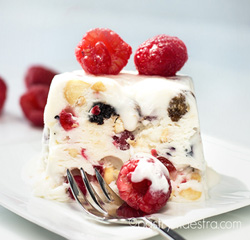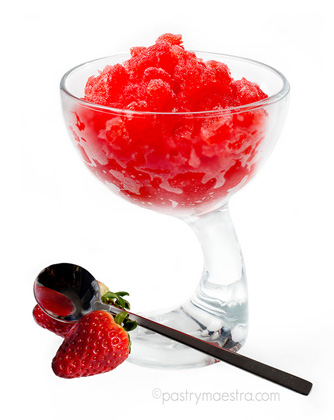“F
rozen dessert!” Now – that’s a nice thought, right? Did you think of an ice cream? I did! The supermarket freezer loaded with different brands and flavors of ice cream, or a local ice cream shop with window display full of freshly made artisan ice cream! Mhm, that image is certainly worth a thousand spoons…sorry – words! I’m so distracted now that only a hefty dosage of frozen delight can repair my train of thoughts, and I think I have just the thing in my freezer! Chocolate, half a gallon of course! O.K! Now I can talk about frozen desserts until brain freeze hits me!
Churned Frozen Desserts
When the ice cream or sorbet mixture is constantly stirred while freezing, it prevents forming of ice crystals. Stirring breaks crystals, but it also adds air to the mixture and makes it lighter.
Ice Cream
Ice cream is a frozen dessert based on crème anglaise which can be made of milk, combination of milk and cream or just cream, egg yolks and sugar. Variety of flavors can be added to crème anglaise before freezing: chocolate, nut pastes, fruit purees and various liqueurs. Chopped nuts, chocolate chips or fresh fruit are added after churning. In order to improve the texture and freezing abilities, stabilizers like gelatin, pectin, carrageenan can be added into ice creams.
No matter what flavor of ice cream you are making, it is of great importance to properly cool ice cream base before freezing. It is recommended to leave the base in the refrigerator for 24 h before churning, so smooth, and velvety texture is achieved.
Sorbet
Sorbet is a churned frozen dessert made of water, sugar and fruit juice, sometimes with wine or liqueur added. It can be served at the beginning of the meal, as a palate refresher between courses, or as a dessert at the end of the meal. When making sorbet, you can use fresh or frozen fruit. It is very important to accurately measure sugar for sorbet because too much sugar will prevent sorbet from freezing, and too little sugar will result with hard and grainy sorbet.

Refractometer is an optical instrument that measures density of liquids, such as sugar syrups, juices and plant saps. Refractometer determines the refraction of light of a liquid. The more sugar the liquid contains, refraction will be stronger. The measurement unit of a refractometer is degrees Brix, after a 19th century German chemist, mathematician and engineer Professor Adolf Ferdinand Wenceslaus Brix (1798-1870).
Fruit sorbet has the best texture when the mixture has density between 31 and 32°Brix.
Still Frozen Desserts
Still frozen desserts are those which don’t need to be stirred while freezing, you can pop them into a bowl or a mold, put them in the freezer, and within a couple of hours you will have wonderful cold treat! No ice cream machine needed here!

Parfait
Parfait [paʁfɛ] (translated from French means perfect) is a still frozen dessert, made of pâte à bombe, whipped cream and flavors (chocolate, fruit, herbs), sometimes with liqueur or other alcohol added. When all the components are incorporated, parfait is placed in mold or glass and then frozen.

Semifreddo
Semifreddo [semiˈfreddo] is another still frozen treat, in Italian it means half-frozen. It is made of Italian Meringue, whipped cream and flavors, put in a mold and frozen. Various nuts and dried fruits can be added to semifreddo in order to improve flavor and texture.

Granita
Granita is still frozen dessert originated from Sicily (Italy), usually made of fruit juice and sugar, but it can contain other flavors. It has less sugar than sorbet, and it is frozen in a shallow dish and scraped with fork or spoon now and then. Granita has grainy structure with fine ice crystals, and it is usually served in a glass or small bowl.
Frozen Soufflé
Frozen soufflé or soufflé glacé is a frozen dessert made of a custard base, gelatin, and whipped cream and Italian meringue. It is poured in soufflé dishes lined with parchment paper. Once set, frozen soufflé resembles the traditional soufflé, but that is the only thing the two desserts have in common.



